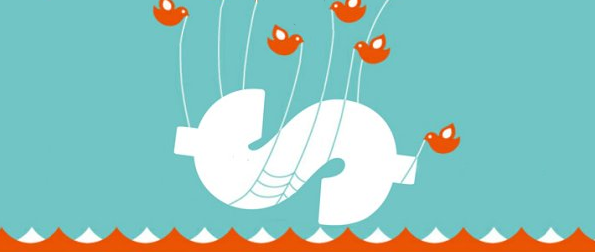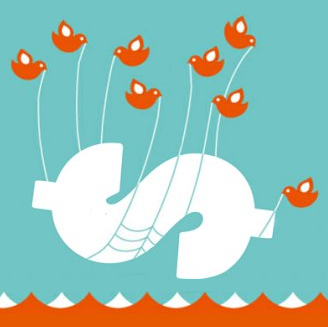In the last few weeks, the journalistic debate about digital media has slowed to a stop, after the wildfires at the beginning of the year of reports which have been much discussed: from Andrew Sullivan’s decision to become self-sufficient, the introduction of native advertising and the analysis of the BuzzFeed ‘case’, arguments that are still recently being debated and analyzed. This week we will talk about Twitter, from the point of view of the user and society, and the relationship between user-generated content and traditional journalism, which can – as has happened in the last few days – result in blatant hoaxes.
by Vincenzo Marino – translated by Roberta Aiello
How much is Twitter worth?
 This is the question many people are asking, finding an initial answer in an evaluation made at the end of January, when the offer to purchase securities by BlackRock, the investment management corporation, implicitly put its value at about $9-10 billion, a gain of 10% compared to the fundraising in the fall of 2011. This week, Dennis K. Berman of the Wall Street Journal investigated the real assessment of the company, considering that $10 billion is a low estimate and believing that Twitter has a good chance of ‘landing’ on Wall Street as one of the best IPOs of 2013. Berman reports that according to eMarketer, the market research company, 2014 revenues for Twitter are forecast between $800 million and $1billion. A remarkable achievement for a company that offers a rather simple service, on a platform that doesn’t need particular maintenance and which ‘works alone’. So what is the secret of Twitter?
This is the question many people are asking, finding an initial answer in an evaluation made at the end of January, when the offer to purchase securities by BlackRock, the investment management corporation, implicitly put its value at about $9-10 billion, a gain of 10% compared to the fundraising in the fall of 2011. This week, Dennis K. Berman of the Wall Street Journal investigated the real assessment of the company, considering that $10 billion is a low estimate and believing that Twitter has a good chance of ‘landing’ on Wall Street as one of the best IPOs of 2013. Berman reports that according to eMarketer, the market research company, 2014 revenues for Twitter are forecast between $800 million and $1billion. A remarkable achievement for a company that offers a rather simple service, on a platform that doesn’t need particular maintenance and which ‘works alone’. So what is the secret of Twitter?
Taking a cue from current events Berman cites the Oscars, an event that, like many others, was ‘experienced’ on Twitter both by users – as a second-screen activity – and by actors, newspapers and other participants in the show. It was relaunched and promoted continuously, reducing TV to – as the author puts it – a lowly portal to social media, and not the other way around. Another element is that Twitter is a platform which offers new and updated content by users, who work for free, creating and cleaning messages. However, Berman warns that the road is not without obstacles. Twitter should begin taking measures against the crisis of advertisers that might depend on users who, once logged in, are reluctant to purchase goods – via promoted tweets – which is unlike what happens on Google – often consulted before a purchase. The article ends by stating that the finding of a solution to this issue, the continuation of current expansion (which remains fast, despite the ban in China) and the attention to maintenance costs are all aspects to be monitored in a year which could be a golden one for the company.
Research on how to get more followers
 This week, Jeff Sonderman in Poynter reported the results of the research study “A Longitudinal Study of Follow Predictors on Twitter” done by the Georgia Institute of Technology. The study reported analysed some 500,000 tweets sent by about 500 active Twitter users (in English, with Twitter accounts that are at least 30 days old, who follow at least 15 other “friends” and have a minimum of 5 followers) over a period of 15 months. It was found that ‘negative feelings’ tend to alienate other users, making the author less attractive as a possible user to follow. Researchers explain that Twitter could be dominated “by very weak social ties” and for this reason negative or aggressive attitudes “could be considered annoying and unpleasant to potential new followers”.
This week, Jeff Sonderman in Poynter reported the results of the research study “A Longitudinal Study of Follow Predictors on Twitter” done by the Georgia Institute of Technology. The study reported analysed some 500,000 tweets sent by about 500 active Twitter users (in English, with Twitter accounts that are at least 30 days old, who follow at least 15 other “friends” and have a minimum of 5 followers) over a period of 15 months. It was found that ‘negative feelings’ tend to alienate other users, making the author less attractive as a possible user to follow. Researchers explain that Twitter could be dominated “by very weak social ties” and for this reason negative or aggressive attitudes “could be considered annoying and unpleasant to potential new followers”.
Another tip which emerged from the study is to avoid sharing too much personal information on Twitter – for the aforementioned lack of social bonds – preferring informative ‘third party’ content, particularly appreciated and effective according to the study, as a way of increasing the number of followers by up to thirty times more. Four out of ten users find the sharing of personal information to be a counterproductive habit. With the “Let’s have a sandwich” style they have undermined the possibility of seeing their own ‘popularity’ grow, compared with only 24% of more ‘informative’ accounts. Interaction is a third element to consider: a greater inclination to the debate which should help in the growth of the number of followers. A positive attitude, a focus on hard information and a judicious interactivity are the most appreciated qualities on Twitter that, translated in the synthesis of Sonderman, “sounds a bit like something your mother told you: ‘if you have nothing nice to tweet, don’t tweet'”.
The goat and the pig
 Last Tuesday, the New York Times reported a non-news story, revealing the making of a video that became ‘viral’ a few days before and was taken up by the media. In a pond there is a goat in danger of drowning. The goat is then rescued by a ‘heroic’ pig – an adjective that was not spared in many programs that reported the ‘news’. The moving and happy-ending video was later revealed to be a hoax created for a new Comedy Central series “Nathan for You” by the editorial staff of the show to promote the launch in an unconventional way. It was a joke on the mainstream media (NBC, ABC and Fox were taken in) and it played on the heavy ‘digital illiteracy’ of traditional newsrooms. They were unable to immediately see through the hoax, fishing without much checking from Reddit and YouTube, where the bait had been carefully placed with a description with clear and intentional spelling errors.
Last Tuesday, the New York Times reported a non-news story, revealing the making of a video that became ‘viral’ a few days before and was taken up by the media. In a pond there is a goat in danger of drowning. The goat is then rescued by a ‘heroic’ pig – an adjective that was not spared in many programs that reported the ‘news’. The moving and happy-ending video was later revealed to be a hoax created for a new Comedy Central series “Nathan for You” by the editorial staff of the show to promote the launch in an unconventional way. It was a joke on the mainstream media (NBC, ABC and Fox were taken in) and it played on the heavy ‘digital illiteracy’ of traditional newsrooms. They were unable to immediately see through the hoax, fishing without much checking from Reddit and YouTube, where the bait had been carefully placed with a description with clear and intentional spelling errors.
In an article titled “What a pig, a goat and an eagle can tell us about the decline of traditional media” Mathew Ingram, in PaidContent, has made this episode a starting point from which to begin a broader discussion about the evolution of the journalistic profession in the newsroom, the redefinition of its borders and the intrusion of external players – the users – in a sphere now easily accessible. He starts from the practice of source checking – which in this case was evidently neglected so as to take full advantage of funny, zero-cost content – and highlights the trend of traditional media to gather and disseminate amateur online material indiscriminately. As in the case of the eagle and the child a few weeks ago, in times of the “democratization of distribution” – as Om said, quoted by Ingram – it’s easy to find news, or at least presumed news, which for reasons of negligence or acquiescence are amplified without much verification. The author warns that it is necessary to give attention to what is amplified, considering that imitating Buzzfeed or Reddit on traditional media can only lead users directly to the original source.
Anyone can be a journalist, not everyone is credible
 This is the theme of user-generated content which makes the boundaries between amateurs and professionals much more flexible, at least in the perception of readers. The topic was discussed during a UNESCO event, a meeting organized by WAN-IFRA (World Association of Newspapers and News Publishers), in a debate – reported on Editors Weblog – that can be considered from different perspectives. If it is true that “everyone has a voice,” as noted by panelist Amadou Matha Ba, Chief Executive Officer of the African Media Initiative, many participants stressed the importance of the role of the journalist in society and the chaos of information, emphasizing the responsibility of choice, collection and reporting of news, maintenance of ethics and professional credibility – a defining and founding feature. In a debate that ranged over different theories and led some to be less inclined to continue to use the term “citizen journalism”, Philippe Massonet, Global News Director of the Agence France-Presse, reminds us that citizens are part of the entire information community and should be treated with respect.
This is the theme of user-generated content which makes the boundaries between amateurs and professionals much more flexible, at least in the perception of readers. The topic was discussed during a UNESCO event, a meeting organized by WAN-IFRA (World Association of Newspapers and News Publishers), in a debate – reported on Editors Weblog – that can be considered from different perspectives. If it is true that “everyone has a voice,” as noted by panelist Amadou Matha Ba, Chief Executive Officer of the African Media Initiative, many participants stressed the importance of the role of the journalist in society and the chaos of information, emphasizing the responsibility of choice, collection and reporting of news, maintenance of ethics and professional credibility – a defining and founding feature. In a debate that ranged over different theories and led some to be less inclined to continue to use the term “citizen journalism”, Philippe Massonet, Global News Director of the Agence France-Presse, reminds us that citizens are part of the entire information community and should be treated with respect.
The meaning of journalism is reporting facts on the spot, as has been shown during natural disasters when people without any kind of professional training testify to what they see with their own, simple means. “That role has to be protected” explained Frank La Rue, UN Special Rapporteur for Freedom of Opinion and Expression: “Journalism is defined by the function, not by the degree.” What is the future? One of the ways to continue could be the imposition of a person with a determined and credible role in the middle of a messy and unverified flow (considering the episode of the ‘hero-pig’). A new and more urgent challenge facing journalists is the following: “We need to transfer our knowledge – said Annette Novak, Board Member of the World Editors Forum – We are moving into the biggest transition of knowledge in the history of the world.”
In a scenario where the players involved are not all professionals but rather new members of an open industry – like simple Twitter users without expertise, says Novak – the industry must find a new way to “revive a dying industry”: training new people, creating new identities, in full connection with an ever less passive audience.


